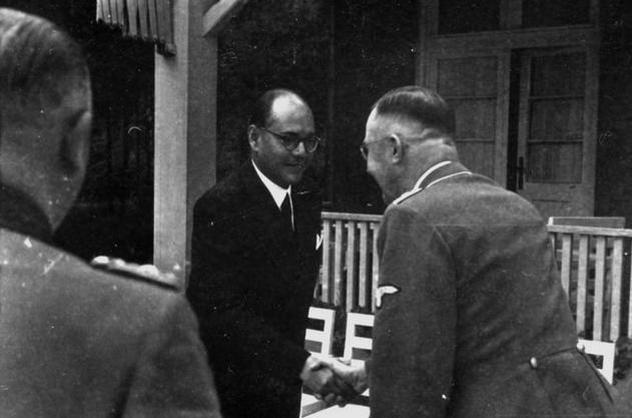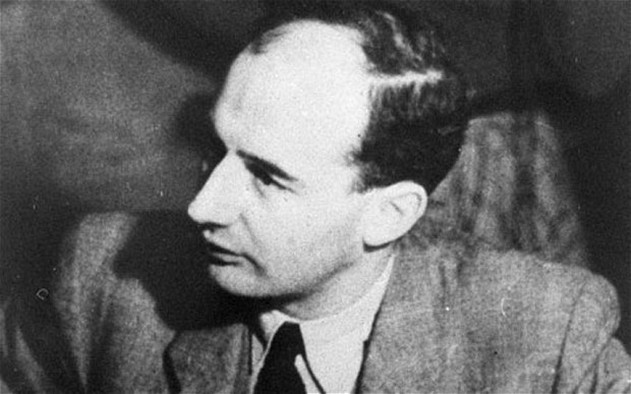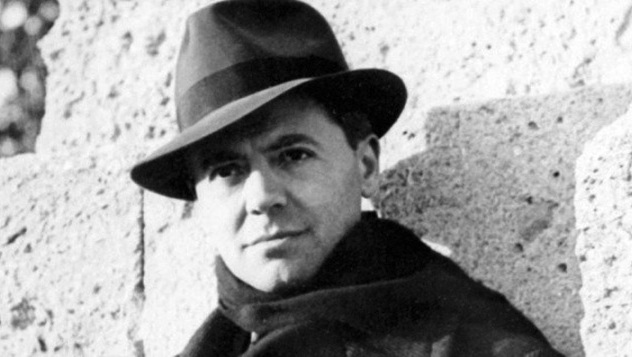 Politics
Politics  Politics
Politics  Weird Stuff
Weird Stuff Ten Bizarre Facts About The Doge Meme
 Our World
Our World 10 Ways Your Christmas Tree Is More Lit Than You Think
 Movies and TV
Movies and TV The 10 Coolest Stars to Set Sail on The Love Boat
 History
History 10 Things You Didn’t Know About the American National Anthem
 Technology
Technology Top 10 Everyday Tech Buzzwords That Hide a Darker Past
 Humans
Humans 10 Everyday Human Behaviors That Are Actually Survival Instincts
 Animals
Animals 10 Animals That Humiliated and Harmed Historical Leaders
 History
History 10 Most Influential Protests in Modern History
 Creepy
Creepy 10 More Representations of Death from Myth, Legend, and Folktale
 Politics
Politics 10 Political Scandals That Sent Crowds Into the Streets
 Weird Stuff
Weird Stuff Ten Bizarre Facts About The Doge Meme
 Our World
Our World 10 Ways Your Christmas Tree Is More Lit Than You Think
Who's Behind Listverse?

Jamie Frater
Head Editor
Jamie founded Listverse due to an insatiable desire to share fascinating, obscure, and bizarre facts. He has been a guest speaker on numerous national radio and television stations and is a five time published author.
More About Us Movies and TV
Movies and TV The 10 Coolest Stars to Set Sail on The Love Boat
 History
History 10 Things You Didn’t Know About the American National Anthem
 Technology
Technology Top 10 Everyday Tech Buzzwords That Hide a Darker Past
 Humans
Humans 10 Everyday Human Behaviors That Are Actually Survival Instincts
 Animals
Animals 10 Animals That Humiliated and Harmed Historical Leaders
 History
History 10 Most Influential Protests in Modern History
 Creepy
Creepy 10 More Representations of Death from Myth, Legend, and Folktale
10 Unsolved Mysteries From World War II
In a global conflict on the scale of World War II, there are a lot of things that slip through the cracks. Whether it’s something that we refuse to admit or simply something so foreign and bizarre that we just don’t know what to make of it, there are still a number of unsolved mysteries from World War II.
10What Happened To The Blutfahne?

In 1923, Hitler made a failed attempt to overthrow the German government and install his own in its place. Spurred on by political actions that implied Germany was taking the fall for starting World War I, the 35,000 members of the Nazi party were aiming high, but their failure set the groundwork—and the mythology—for the rise of their party years later. Hitler and 600 of his men attempted to take over a beer hall at which the Bavarian Prime Minister was speaking . . . and Hitler managed to gain the support of the audience. Now with 3,000 men, the Nazis attempted to take key government buildings. It was a failure, though. Hitler was arrested two days later and tried for treason.
During the shootout, 16 Nazi party members died. After Hitler was released from prison, he was given a flag that had been stained with the blood of his fallen comrades—they became the first martyrs of the Nazi party. The flag became known as “Die Blutfahne,” or “the Blood Flag,” and it was one of the earliest symbols of the mythos and ritual that would grow around the Nazi party. It was used in all the major ceremonies, its touch was thought to sanctify other flags with its power, and SS officers swore their oath to it. It even had its own keeper: an SS member named Jakob Grimminger.
The last time Die Blutfahne was seen in public was in October 1944. No one knows whether it was destroyed in the bombings at the end of the war, rescued and shuttled away, or whether an unwitting Allied soldier took it, unaware of its significance. The keeper of the Blood Flag not only survived the war, but later took a minor position as a city official in Munich. All his property had already been confiscated, and he died a poor man.
9The Death Of Subhas Chandra Bose

Subhas Chandra Bose was the leader of the Indian National Army during the years surrounding World War II. From the Allied point of view, he was a dangerous traitor; Bose had visited both German and Japanese leaders and had been in the friendly company of Stalin. His actions have long been up for debate, with supporters saying that he was less interested in following along with Axis ideals than he was in finding an enemy of the British he could ally himself with. The stories of Bose’s life are worthy of a Bond movie—escaping British surveillance, fleeing to Italy, covert meetings, and taking different identities . . . there’s a lot that’s still unknown about the Indian revolutionary. One of the things that’s always been questioned is how he died.
According to the official story, Bose died in a plane crash in 1945. His body was cremated, and his ashes were taken to a place of honor at the Renkoji Temple near Tokyo. There are a lot of people that don’t believe the story, though; some even have gone so far as to name the man whose ashes really sit in Bose’s place: They say the ashes belonged to Ichiro Okura, a Japanese officer from a Taiwanese army. It’s claimed that the plane crash story was fabricated in order to throw people off the trail of the real Bose.
The entire country is still hoping that they might one day find out what happened to their patriotic leader, but it’s not going to be happening anytime soon. On December 1, 2014, the National Democratic Alliance refused another request to make public the classified files that are being held on Bose. There are 39 files that have been withheld from the public in varying degrees; in some cases, their contents—but not the actual files—have been divulged. The government also refused to publish documents that have already been marked as “Unclassified.” According to the public information officers responsible for denying the request, it was done because the information contained in the documents could in some way harm India’s relationships with other countries.
8The British Soldiers Of Auschwitz

In 2009, historians were doing routine maintenance on one of the buildings at the most infamous Nazi death camp of them all: Auschwitz. During their work, they uncovered a strange list. It contained the names of 17 British soldiers. There were check marks next to eight of the names. No one knows what the list was for. Also written on the paper were a few German words—and these words don’t make the mystery any clearer. The words that have been identified are “since then,” “never,” and “now.”
There are a couple of guesses about the purpose of the list and who the men were. One is that they were British prisoners of war—there were many housed at Auschwitz in the E715 camp, where they were put to work laying cables and pipes, loading freight cars, or in skilled laborer positions. Another theory is that the names on the list were British men who had switched sides, working for the British SS Division during the war.
7The Ness Gun Battery’s Mystery Artist
The Ness Gun Battery in Orkney was one of many sites that made up an invaluable defensive perimeter around the British Isles. During the war, it was manned by soldiers who protected a naval anchorage called Scapa Flow. While they were there, someone created something stunning: a mural that decorates one of the walls in the mess hall. It shows a rural English village, a cottage, and several caravans; images of home, presumably, and of a life much more idyllic than the one the men were living. There’s a signature—“A.R. Woods”—but no one’s sure who he really was.
The site is also notable for being the only surviving gun battery with the original, World War II–era wooden buildings. Conservation and restoration efforts uncovered the beautiful mural. Since then, a request was put out for any information on the identity of “A.R. Woods.” Suggestions have come in from all over the world, but nothing’s panned out yet. One man named A.R. Woods is thought to be a likely candidate, but there’s no conclusive evidence in the surviving documents about the staff at Orkney. The Orkney Islands Council are hoping to find the man—or his descendants—someday. For now, they’re just preserving the mural.
6Hitler’s Missing Globe
Charlie Chaplin made it famous in his film The Great Dictator, where he portrayed a megalomaniac dictator dancing with a massive globe. It was inspired by a globe that really did sit in Hitler’s office and is now missing. There’s one on display at the Markisches Museum, but it didn’t belong to Hitler. There existed a handful of these giant, small-car-sized globes. They were called the “Columbus Globes” and were made in two limited-edition runs (the second run made minor corrections to the maps). Some of the globes were presented to Hitler and other leaders of the Nazi party, and they were supported by specially designed custom stands. The stand from the photographs of Hitler’s office doesn’t match the one that’s long been claimed to be his.
It’s not known what happened to this giant artifact. A lot of these globes have survived, many in museums or in private collections. Hitler’s is not among them, despite being one of the most iconic artifacts in pop culture. It’s almost as famous because of Charlie Chaplin as it is for belonging to Hitler—having been turned from a symbol of power to a mocking jab at egomania. One retired cartographer has been documenting other globes and where they’ve come from. He’s managed to identify globes that belonged to other Nazi officers, but Hitler’s globe remains elusive.
5What Really Happened To Raoul Wallenberg?

Wallenberg was a Swedish businessman who worked during the war to not only establish hospitals, soup kitchens, and safe houses throughout Budapest but also to provide false papers to Jews threatened with concentration camps. By the time Budapest was liberated in 1945, more than 100,000 Jews remained safely in the city because of papers provided by Wallenberg and his associates.
Wallenberg was arrested by the Soviets in 1945. What happened to him after that is a mystery. According to one Soviet report by a supposedly attending physician, he died in 1947 after suffering a heart attack while being held in Lubyanka prison. However, there are also conflicting reports that refer to Wallenberg as “Prisoner 7,” who was subjected to 16 hours of questioning in July 1947—a week after he supposedly died. Russian responses to inquiries about his fate have been mixed. Some have indicated that there were no more documents about Wallenberg in their archives, while others admitted that the questions being posed about his fate were legitimate and further answers could be expected. In 2009, a letter delivered to the Swedish Embassy in Moscow hinted that the case wasn’t closed yet but didn’t give any more information.
4What Really Happened To Heinrich Mueller?
Heinrich “Gestapo” Mueller was one of a handful of Nazi leaders who have continued to evade capture for decades; the head of the Gestapo, he disappeared during the final days of the war. Although numerous theories have circulated about his fate, nothing has ever been confirmed. Until now, it seems. According to a report by a German historian, there’s evidence that Mueller died in Berlin and was buried in a mass grave in a Jewish cemetery. The evidence includes a death certificate for Mueller, dated December 1945, and a 1963 testimony of a gravedigger who claimed he’d buried a uniformed German officer along with the other dead. He also matched Mueller’s face to the body.
At a second glance, though, the evidence leaves more questions than answers, and not everyone is so quick to support the above theory. Experts at the Simon Wiesenthal Center point out that many Nazis had fake documents—including death certificates—to help them disappear and make it out of Germany after the end of the war. Also, if Mueller was buried in a mass grave, there’s almost no chance of getting DNA confirmation that the body is actually his. Well after the war, there were rumors of Mueller being spotted in places like Cuba and Argentina, but no one’s ever been able to prove anything.
3Who Really Betrayed Jean Moulin?

Jean Moulin was one of the organizers of the French Resistance. On June 21, 1943, someone had alerted the local Gestapo that there was going to be a meeting of Resistance leaders in Caluire. Gestapo stormed the meeting and arrested Moulin and other senior resistance leaders. Moulin had been arrested before, but after being tortured in Montluc Prison by the German secret police, he was shipped off to Berlin. He died en route.
No one has ever been able to figure out just how the Gestapo knew about the meeting. At the time, Moulin and his associates pointed the finger at a junior member of the Resistance named Rene Hardy. At the time of the arrest, Hardy was the only one who wasn’t handcuffed; when he made a run for freedom, the only response of the Gestapo was to fire a few random shots in his direction. Raymond Aubrac, Moulin’s fellow Resistance leader who survived the war, always maintained it had been Hardy, but he never had any proof.
Aubrac was arrested along with Moulin but was freed by his wife, Lucie, and their associates. Lucie, who was pregnant at the time, convinced Aubrac’s captors to allow her to marry him in prison so their child was not born illegitimate. They allowed it, and Aubrac ultimately escaped. Klaus Barbie, the Gestapo officer in charge of the Resistance prisoners, also survived the war and fled to South America. Before dying in 1983, he issued a statement that pointed the finger at the Aubracs as the traitors. His claims were picked up in a book, and the Aubracs went to court over it. They were ultimately cleared, but that’s the kind of accusation that never really goes away. Lucie died in 2007, Raymond Aubrac in 2012. They maintained their innocence until their deaths. No concrete evidence has ever been found of just who betrayed Jean Moulin.
2Who Betrayed Anne Frank?
Anne Frank’s diary changed the way we look at World War II. It took the conflict from something mind-bogglingly massive and turned it into something very, very personal. We all know how the story ends. The warehouse where the family hid for two years was raided in 1944; the eight people hiding there were arrested, and only Otto Frank, Anne’s father, lived through the war. It was an anonymous phone call that led the Gestapo to their hiding place, and no one has ever been able to say—conclusively—who made that call.
There are plenty of theories. One theory says that it was Tonny Ahlers, a friend of Otto Frank’s from several years before they went into hiding. In 2002, a biography of Otto Frank was published, and Anton Ahlers came forward claiming that it was his father who had betrayed the family. Anton painted the picture of a hateful, abusive man who confessed to his granddaughter that he had been there when the Franks went into hiding . . . and was there when they came out again. Earlier investigations have also suggested that the phone call may have come from warehouse employees; during a 1948 investigation, employees at the warehouse stated that they had known about the hiding family two weeks prior to their capture. The records of the questioning are sorely incomplete.
One of the most frequently named possibilities for the betrayer is the warehouse manager, Willem van Maaren. Van Maaren was known for stealing from the warehouse, but by the time suspicion was really turned on him, many of the people who could have testified against him were already dead—including the Nazi officer who took the phone call (Julius Dettman committed suicide not long after the end of the war). There’s also the possibility it was a woman named Lena Hartog-Van Bladeren. A cleaning lady and wife of one of the warehouse employees, she testified to knowing there were Jews being hidden on her employer’s property. She also said she feared for the safety of her husband should they ever be caught.
1Who Was The Dead Body From Operation Mincemeat?
When the Allied troops settled on Sicily as a major target, the next part of the plan was to convince the Axis powers that they were headed somewhere else. They turned to a plan that had been concocted by an assistant to the head of British Naval Intelligence—a man named Ian Fleming. Fleming pitched a number of ideas on how to mislead the Axis officers, including one that involved forged papers with false information being planted on a dead body. They dubbed it “Operation Mincemeat” and went ahead with the plan. The body—with falsified documents that identified it as Major William Martin of the Royal Marines—was dumped off the coast of Spain, which was officially neutral but had pro-Axis leanings. The body was recovered in 1943, and once the message it carried was relayed, Axis troops were diverted away from Sicily and into Greece—leaving the intended target wide open.
There’s debate about the identity of the dead man. In 2003, a documentary claimed that the body belonged to a British soldier who was on the ill-fated HMS Dasher—an aircraft carrier that sank in 1943. The documentary named the man as Tom Martin. The following year, there was a memorial service for the crew of the Dasher. During the service, a special commendation was given to a man named John Melville, saying that it was his body that was used in Operation Mincemeat. More recently, a Canadian historian has put forth the idea that none of that is true and that the body actually belonged to a mentally ill, homeless Welshman named Glyndwr Michael. Michael had died after eating rat poison, the historian says, and his body was then used for the operation.
However, the last theory has its detractors, who say that the entire plan hinged on the body—and its message—being believed. That meant the body not only had to be in the right condition, but it had to have the physique of a Royal Marine. Michael’s body absolutely didn’t. He was said to have been an alcoholic—even his dental records had shown wear and tear that wouldn’t have been up to the standards of the Royal Marines. Naysayers claim that this makes it highly unlikely that the body was Michael’s.








